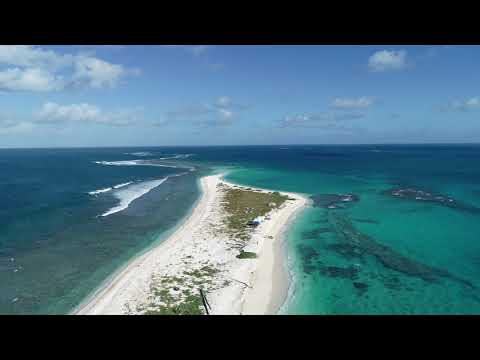
Remote Hawaiian island washed away earlier this month.
Hurricane Walaka, one of the most powerful Pacific storms ever recorded, has erased an ecologically important remote northwestern island from the Hawaiian archipelago.
Using satellite imagery, federal scientists confirmed Monday that East Island, a critical habitat for endangered Hawaiian monk seals and green sea turtles, was almost entirely washed away earlier this month.
“I had a holy shit moment, thinking ‘Oh my God, it’s gone,’” said Chip Fletcher, a University of Hawaii climate scientist. “It’s one more chink in the wall of the network of ecosystem diversity on this planet that is being dismantled.”
Fletcher was doing research in July on East Island, which is part of French Frigate Shoals in Papahanaumokuakea Marine National Monument. He said he knew East Island would eventually be underwater; he just thought it would take another couple decades or more for rising seas to swallow it up.
Instead, a Category 4 hurricane eliminated it overnight.
The hurricane’s pathway wasn’t a function of climate change, he said, but its strength and timing were consistent with the effects of a warming ocean and rising global temperatures that make storms more intense.
And part of the island’s demise was just bad luck, Fletcher said, describing the fishhook trajectory that Walaka took when it turned north and directly hit East Island.
The monument’s state and federal managers said they won’t know the full toll until they can get out there to assess the damage. A marine debris team was already set to go up later this week, and could provide some preliminary observations.
It’s unclear if East Island — an 11-acre spit of sand and gravel that hosted a U.S. Coast Guard radar station until 1952 — will ever return or how resilient the displaced animals will be.
About 96 percent of Hawaiian green sea turtles, a threatened population under the Endangered Species Act, nest in French Frigate Shoals, over half of which on East Island. And about one-seventh of the world’s critically endangered Hawaiian monk seals were born there, according to Charles Littnan, a conservation biologist with the National Oceanic and Atmospheric Administration.
“There’s no doubt that it was the most important single islet for sea turtle nesting,” he said.
Fortunately, Littnan said, the seals and turtles that rely on French Frigate Shoals are most likely fine — at least in the short term — because most had already left for the season before the storm hit.
The turtles come down to the Main Hawaiian Islands after they breed on East Island, which is about 550 miles northwest of Honolulu. A team of seven researchers, who were evacuated before the storm, counted 113 turtles nesting there this year.
French Frigate Shoals used to be the largest breeding ground for Hawaiian monk seals but has seen a decline in recent years. Still, about 16 percent of the entire population lives at French Frigate Shoals, and about 30 percent of those that live there had their pups on East Island, making it an important breeding site, Littnan said.
Roughly 1,100 of the entire population of 1,400 Hawaiian monk seals live in the Northwestern Hawaiian Islands. The rest live in the Main Hawaiian Islands.
Littnan said monk seals of all ages have successfully weathered severe storms for years but he won’t know the effects of this storm until researchers return next year to survey the population.
A team of researchers from the University of Hawaii was there this summer to study the migratory patterns of tiger sharks. The sharks go to the waters around East Island during a two-week window each year to feed on fledgling albatross. The chicks take off from East Island, but often land in the water just offshore on their maiden flights — an easy meal for the sharks.
“Species are resilient up to a point,” Littnan said, noting that the animals can redistribute. “But there could be a point in the future where that resilience isn’t enough anymore.”
Littnan said it appears that storm-powered waves washed over all of the islets within the 20-mile crescent-shaped reef that is French Frigate Shoals, with East Island being the hardest hit.
Scientists won’t know until next summer’s expedition what the underwater toll is, but they are assuming tons of sediment has covered parts of the coral reef system surrounding the island.
Randy Kosaki, the monument’s deputy superintendent for research and field operations for NOAA, said French Frigate Shoals now appears to have lost two islands over the past two months.
The difference is that scientists forecast the demise of nearby Trig over the course of years, whereas East Island disappeared virtually overnight.
Whale-Skate Island, which slowly eroded until the late 1990s when it became submerged, has not made a return.
Kosaki said it’s hard to tie any particular hurricane to climate change, but the overall trend of increasing and strengthening storms points that way.
“The take-home message is climate change is real and it’s happening now,” Kosaki said. “It’s not a hoax propagated in China as some folks have said.”
Even if East Island reemerges, he said, it will take time for it to revegetate and become stable again. And it would take years for the surrounding corals to make a comeback if they were destroyed too, as suspected.
“Right now we have more questions than answers,” Kosaki said.
The monument’s management board, which includes state and federal partners, plans to discuss the issue at its meeting next week.
Athline Clark, NOAA’s superintendent of Papahanaumokuakea, said the apparent loss of East Island will have broader implications for French Frigate Shoals and the monument as a whole.













